Ploug House
Ploug House (Danish Plougs Gård) is a listed Neoclassical property on the corner of Højbro Plads and Ved Stranden in central Copenhagen, Denmark. It dates from the building boom which followed after the Copenhagen Fire of 1795 but takes its name after the poet, publisher and politician Carl Ploug who lived there in the 1860s and 1870s and also published the newspaper ''Fædrelandet from the premises.
| Ploug House | |
|---|---|
Plougs Gård | |
.jpg.webp) Ploug House with the spire of the former St. Nicolas' Church in the background | |
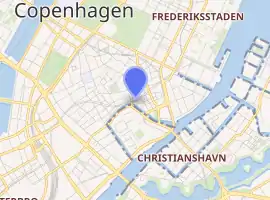
| |
| General information | |
| Architectural style | Neoclassical |
| Location | Copenhagen, Denmark |
| Country | Denmark |
| Construction started | 1798 |
| Completed | 1799 |
| Client | C. F. Friderici |
| Design and construction | |
| Architect | Andreas Hallander |
History
Early history
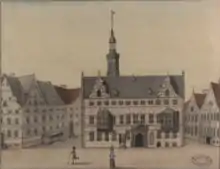
Christian IV's mother-in-law Ellen Marsvin constructed a large, Renaissance style house at the site in the 17th century. It was used for housing the Swedish military officer Magnus Stenbock during his five years in Danish captivity. The Marsvin House was destroyed in the Copenhagen Fire of 1795 along with most of the other buildings in the area.
The current building at the site was constructed on the foundation of the old house in 1798–99 by Andreas Hallander for C. F. Friderici, a wealthy merchant.[1]
The anatomist Herman Treschow Gartner (1785-1827) lived in the building in 1823-24. J. D. Brandis (1762-1845), Queen Maria Sophie's physician, resided there until 1829.
The Melchiors and H. C. Andersen
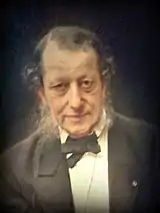
.jpg.webp)
Moritz G. Melchior, the owner of Moses & Søn G. Melchior, acquired the building in 1855. He lived with his family on the second floor and also ran his company from the premises. The Melchior family were among Hans Christian Andersen's closest friends. He stayed with the family from 13 March until 21 May 1870 in their residence on Højbro Plads, where he wrote What the Whole Family Said,[2] and the Melchiors also hosted the celebration of his 70th birthday. Andersen usually visited the family for dinner on Thursdays. Other friends of the family, who would often also attend the Thursday Dinners, included the painters Carl Bloch and Frederik Christian Lund, poet and museum administrator Carl Andersen and representatives of the press such as Dagbladet editor C. St. A. Bille, journalists Robert Watt and P." Cabiro" Hansen and publisher and editor of Fædrelandet ("The Fatherland") Carl Ploug.[3]
Carl Ploug and later history
.jpg.webp)
Carl Ploug purchased the property from Melchior in circa 1862. The Melchior family remained on the second floor while Ploug moved in with his family on the third floor. Melchior's unmarried daughter Louise Melchior continued to live in the house until her death in 1934.[3]
.jpg.webp)
Ploug also started to publish Dædrelandet from the building, which now also became known as Fædrelandets Hus ("The Fatherland Building). Jens Giødwad, one of Ploug's colleagues from the newspaper, was also a resident in the building from 1864 to 1869.
The tobacco manufacturer Heinrich Hirschsprung, the owner of A.M. Hirschsprung & Sønner, lived with his family in one of the apartments facing Højbro Plads from 1872 to 1880. Hirschspring was the owner of a large art collection and his home was frequented by artists such as Vilhelm Marstrand, Peder Severin Krøyer, Vermehren and Anna and Michael Ancher.
The painter Erik Henningsen lived on the third floor at Høkbro Plads 21 from 1913 to 1915. The Ploug owned the property for more than 50 years.[3]
The seed company Hjalmar Hartmann & Co. was based in the building (No. 21) in 1995.
Architecture
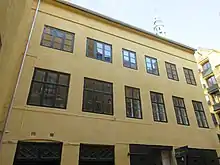
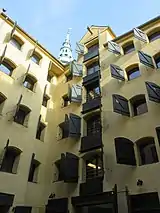
The house is designed in the Neoclassical style. It consists of four storeys and a cellar and has six bays towards Højbro Plads and seven towards Ved Stranden. The facade is decorated with pilasters. The "bevel" corner is typical for the buildings of the period, being a requirement under the new building regulations to facilitate the fire corps' passage through the city in the event of fire.[4]
Today
The complex consists of a combination of offices and housing. Vica Wood, a manufacturer of flooring, is based at No. 21 B.
See also
References
- "Ved Stranden 20 / Højbro Plads 21-21a-b" (in Danish). indenforvoldene.dk. Retrieved 2012-09-15.
- "Højbro Plads og H.C.Andersen" (in Danish). H. C. Andersen Information. Archived from the original on 20 November 2007. Retrieved 16 September 2012.
- "H. C. Andersens brevveksling med familien Melchior" (in Danish). H. C. Andersen Centretaccessdate=30 January 2019.
- "Københavns brande" (in Danish). Gyldendal. Retrieved 2012-09-16.
External links
| Wikimedia Commons has media related to Plougs Gård. |
